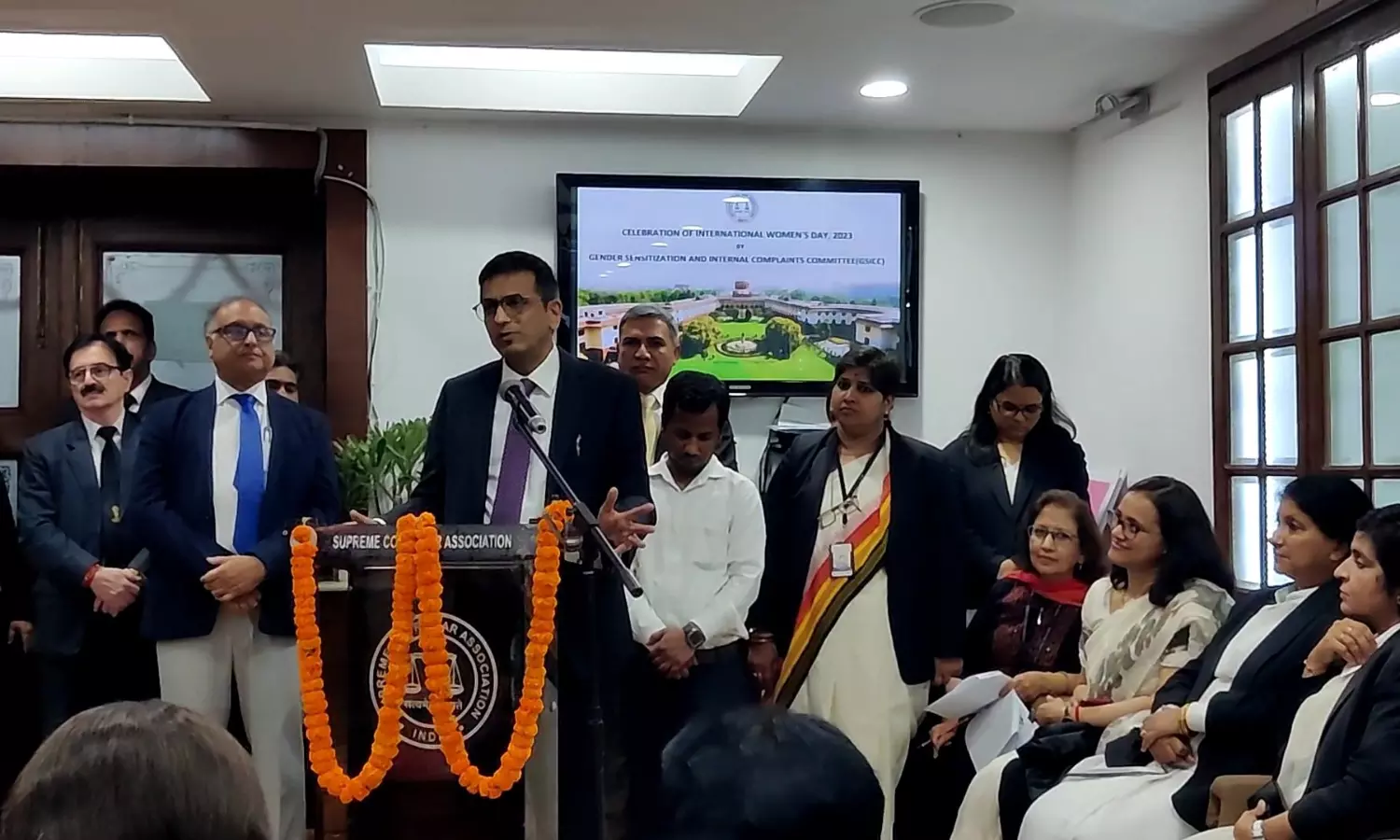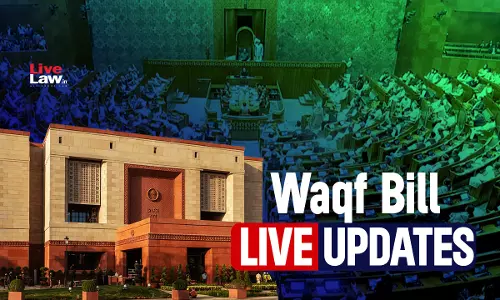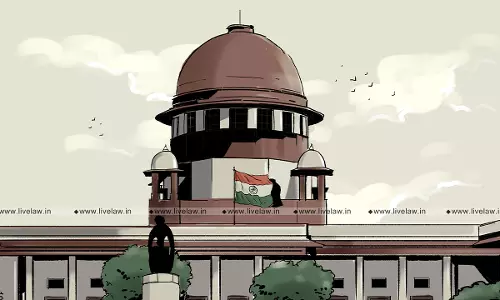Must Ensure Zero Tolerance For Inappropriate Behaviour Towards Women, Sexist Language & Unsavoury Jokes : CJI DY Chandrachud

There must be zero tolerance for sexual harassment and inappropriate behaviour towards women, inappropriate language targeting women, and even inappropriate jokes at the expense of women, said Chief Justice of India DY Chandrachud. Justice Chandrachud was speaking on Wednesday at an event organised by the Gender Sensitisation and Internal Complaints Committee of the Supreme Court for...
There must be zero tolerance for sexual harassment and inappropriate behaviour towards women, inappropriate language targeting women, and even inappropriate jokes at the expense of women, said Chief Justice of India DY Chandrachud.
Justice Chandrachud was speaking on Wednesday at an event organised by the Gender Sensitisation and Internal Complaints Committee of the Supreme Court for a belated celebration of International Women’s Day (March 8). Also in attendance were the chairperson of the committee, Justice Hima Kohli and other members, including Justice BV Nagarathna. Among other dignitaries, former Supreme Court judge Indira Banerjee was also present in the audience.
Delivering the keynote address, Justice Chandrachud, who was invited as the chief guest, highlighted both good and promising developments in the legal profession, such as the increasing number of women in judicial services and transactional law, as well as unpleasant aspects that need to be addressed, including the presence of systemic barriers, and incidents of inappropriate behaviour, sexual and otherwise, targeting women. He also made two important announcements – first, the launch of a glossary of inappropriate gendered terms used in legal discourse, and second, the creation of a large space for women lawyers in the Supreme Court’s annexe building which is about to be renovated. We take a look at the highlights of the chief justice’s address.
Zero tolerance for inappropriate behaviour towards women, inappropriate language about women, and even inappropriate jokes
Notably, Justice Chandrachud pointed out that one of the problems in the profession was the harassment of women and inappropriate behaviour towards them. The Chief Justice revealed that he had heard ‘ghastly’ stories involving young, women lawyers in the profession, and arising out of the corridors of the top court itself. There must be zero tolerance for sexual harassment and other inappropriate behaviour targeting women, Justice Chandrachud firmly stated. He said:
“Even if part of those stories that I was told are believable, and I see no reason not to believe them because I think every one of them has a germ of trust, we need to ensure that there is zero tolerance for inappropriate behaviour towards women, use of inappropriate language in relation to women, and even on cracking inappropriate jokes in the presence of women.”
The chief justice recalled, “There were instances when I was a young lawyer, of seniors sitting in a group cracking a ‘joke’ at the expense of a woman lawyer there, which would be extremely unbecoming. No one then had the guts to tell the senior that the language was inappropriate. But we have come a long way now.” He added that people now realise that some forms of behaviour – physical, language-based, action-based, or symbolic – are plainly unacceptable, particularly in the workplace. “We need to emphasise this that these kinds of behaviour are not acceptable. It is also important to send this message to the authorities. Excesses do not begin in the corridors. They continue as you go higher and higher in terms of authority. It is important to recognise that and put an end to it.”
·Number of women in district judiciary and transactional law today holds great promise for tomorrow
With respect to gender diversity in the legal profession, Justice Chandrachud offered a hopeful prognosis for the days to come. “You know the time when women in this profession were far and few between, with an odd woman seen struggling across the board,” he began. But now it has completely changed, said the CJI who has almost four decades of combined experience at the bar and on the bench.
Pointing to the latest figures, he said that over fifty per cent, and in some states over sixty per cent of judicial officers are women. The chief justice then added, “This holds great promise for the future because these women who are entering into the workspace today are going to define the values, the traditions, and the aspirations for the present and the future.”
Other than the district judiciary, Justice Chandrachud also cited the example of the transactional lawyering space. “There is a large number of women entering the transactional lawyering space for the reason that it is a space where merit is truly rewarded - where a woman is employed not because she is a woman or to give her another chance, but in recognition of her talent and the fact that she is as competent as her male counterparts.”
The examples that have been set in the district judiciary and in transactional law must now make their way to other parts of the legal profession, “namely seniors’ chambers, the courtroom, and in appointments to the high courts”, the chief justice said.
Need to send a message that the top court is an equal opportunity employer and workspace
Justice Chandrachud allowed an unusual look into his personal relationship with his women colleagues, current and former. He revealed that on March 8, he had sent a message to all his ‘sisters on the bench’ that read:
“Happy Women's Day. Wishing you strength, courage and an abiding vision to serve as a role model and mentor to women, men and everyone in society on their journey towards a gender-equal society. Warm regards, Dhananjay.”
After reading out this message, Justice Chandrachud explained the reason for his emphasis on it, by saying, “Celebrating women’s day is not something which is confined to women. It is really a recognition of the position of women in a global society. But this is something not just for women to celebrate, but for all of us to celebrate because we exist together, and we cannot exist without the other.” Celebrating Women's Day in the Supreme Court has a special significance, the chief justice added. “We have to send the message that we are a truly gender equal and an equal opportunity employer and an equal opportunity workspace.”
Women lawyers face barriers that prevent the full realisation of their potential
Notably, Justice Chandrachud also spoke about the continuing existence of severe barriers which, among other things, derailed mid-career women, even though more and more young and talented women have been entering the legal profession every year. “Most of my law clerks are women, with an odd sprinkling of a male law clerk. This is perhaps a sign of the time and an indication of how much education has reached out to women in our society,” Justice Chandrachud said. “But then why are we not able to convert the promise and potential to reality?” the judge asked. He answered his own question by saying, “At some point in time, women encounter barriers. These are not barriers to entry, but barriers to the full realisation of the potential of women lawyers.” He pointed out that many women were forced to drop out of their profession. “This is because we have not working conditions that would make women feel accepted.”
Looking beyond becoming an equal opportunity workspace into ensuring an equal opportunity profession
A lot of work needs to be done both in the bar and the bench towards making law an equal opportunity profession, as distinct from an equal opportunity workspace. “We have to look beyond making the Supreme Court an equal opportunity workspace, which is a mission that the gender sensitisation committee has undertaken, into making the field of law an equal opportunity profession.”
Senior members of the profession would have to be more welcoming of women, “and not treat women as someone who would work for a few years and leave”, Justice Chandrachud insisted. The perception, he continued, would have to change and seniors would have to acknowledge that women are vital and helpful members of the workforce who have to be compensated adequately for their work. At the same time, the judiciary must also give a more concerted effort at ensuring that women assumed important roles of responsibility in the judicial system.
He elaborated on this issue by contrasting the number of women becoming judicial officers with the number of women lawyers. “Why do we not have as many women lawyers entering the profession across India, not in the Supreme Court, but in high courts of various states?” he asked. Justice Chandrachud revealed:
“There are states where colleagues say that it is impossible to find a woman lawyer who can be appointed as a judge of the high court. If that is reality, then the blame must lie on us for not being able to create conditions allowing women to flourish in the legal profession and join the higher judiciary. Therefore, a large degree of responsibility must lie on us today to create conditions in which women can practice on an equal platform as men, and therefore, be recognised as equal contributors. In my experience, the young women lawyers appearing before me can be virtually marked out for their dedication, for not misleading the court, for being extremely fair, and sometimes even very tough, even with the court.”
It was the ‘bounden duty’ of lawyers and judges alike to collaborate in transforming the legal profession into an equal opportunity one, Justice Chandrachud said, with great conviction.




